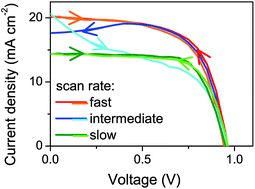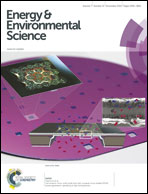Hysteresis and transient behavior in current–voltage measurements of hybrid-perovskite absorber solar cells†
Abstract
Hybrid organo-metal halide perovskites are an exciting new class of solar absorber materials and have exhibited a rapid increase in solar cell efficiencies throughout the past two years to over 17% in both meso-structured and thin-film device architectures. We observe slow transient effects causing hysteresis in the current–voltage characterization of these devices that can lead to an over- or underestimation of the solar cell device efficiency. We find that the current–voltage (IV) measurement scan direction, measurement delay time, and light and voltage bias conditions prior to measurement can all have a significant impact upon the shape of the measured IV light curves and the apparent device efficiency. We observe that hysteresis-free light IV curves can be obtained at both extremely fast and slow voltage scan rates but only in the latter case are quasi-steady-state conditions achieved for a valid power conversion efficiency measurement. Hysteretic effects are also observed in devices utilizing alternative selective contacts but differ in magnitude and time scale, suggesting that the contact interfaces have a big effect on transients in perovskite-absorber devices. The transient processes giving rise to hysteresis are consistent with a polarization response of the perovskite absorber that results in changes in the photocurrent extraction efficiency of the device. The strong dependence of the hysteresis on light and voltage biasing conditions in thin film devices for a period of time prior to the measurement suggests that photo-induced ion migration may additionally play an important role in device hysteresis. Based on these observations, we provide recommendations for correct measurement and reporting of IV curves for perovskite solar cell devices.


 Please wait while we load your content...
Please wait while we load your content...